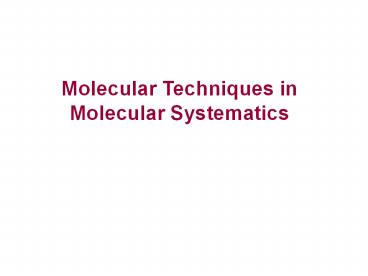Molecular Techniques in Molecular Systematics PowerPoint PPT Presentation
Title: Molecular Techniques in Molecular Systematics
1
Molecular Techniques in Molecular Systematics
2
DNA-DNA hybridisation
- Measures the degree of genetic similarity between
pools of DNA sequences. - Normally used to determine the genetic distance
between two species. - The method compares the melting of a labeled
sample after it is hybridized to iteself vs its
melting after hybridized to unlabeled DNA of
another organism.
3
RAPD, AFLP, Minisatellites
- Data is scored as presence (1) or absence (0) of
a DNA band/fragment. - Suitable for studies involving closely related
taxa because the variation detected by these
markers is high. - Homology problem may arise due to co-migration of
DNA bands/fragments.
RADP data
4
PCR-RFLP / CAP
- Data scored as presence (1) or absence (0) of a
restriction site. - 4-base and 6-base cutters are used to generate
data. - Data scoring becomes difficult if the variations
involve length mutations (deletions or insertions
/ indels)
5
CAPS
PCR products of the trnS-trnM region (cpDNA)
restricted by TaqI
580 bp
290 bp
180 bp
580 bp
180 bp
180 bp
290 bp
290 bp
6
PCR-RFLP / CAP
- The probability of restriction site loss is
higher than restriction site gain. - A site loss could be due to various
character-states (conditions).
Restricted by DraI (TTTAAA)
Taxon Species A Species B Species C Species D
Species E
Sequence CGTATTTAAACCGCTC
CGTATTTAAACCGCTC CGTATTCAAACCGCTC
CGTATTGAAACCGCTC CGTATTTCAACCGCTC
Restriction Cut Cut No Cut No Cut
No Cut
7
DNA Sequencing
- DNA data is multiple state data. It normally
exist in 4 different bases (A, T, C and G). - DNA data must be aligned (multiple sequence
alignment) in order to be scored. - CLUSTAL software is used to align DNA sequences.
8
DNA Sequencing
Multiple Sequence Alignment using CLUSTAL
9
DNA Sequencing
- The evolution of DNA sequences is various
depending on DNA regions (protein coding region,
non-protein coding region, intergenic spacer,
intron, repetitive DNA region etc.) - For protein coding region, the mutation rate for
synonymous base substitution is higher than
non-synonymous base substitution.
Taxon Species A Species B Species C
DNA Sequence TTT GTT TGG TTT GTA TGG TTT TTT
TCG
Amino acid sequece Phe-Val-Trp Phe-Val-Trp
Phe-Phe-Trp
10
Amino Acid Sequencing
- Amino acid sequencing was practiced before the
establishment of DNA sequencing methods. - Amino acid data is a multiple state data. It
consists of 20 states (20 different amino acids).
11
Single-Letter Amino Acid Code
G - Glycine (Gly) P - Proline (Pro) A - Alanine
(Ala) V - Valine (Val) L - Leucine (Leu) I -
Isoleucine (Ile) M - Methionine (Met) C -
Cysteine (Cys) F - Phenylalanine (Phe) Y -
Tyrosine (Tyr)
W - Tryptophan (Trp) H - Histidine (His) K -
Lysine (Lys) R - Arginine (Arg) Q - Glutamine
(Gln) N - Asparagine (Asn) E - Glutamic Acid
(Glu) D - Aspartic Acid (Asp) S - Serine (Ser)
T - Threonine (Thr)
12
Amino Acid Sequencing
- Amino acid sequencing is time consuming. It is
done by HPLC approach. - At present the amino acid sequences are generated
mainly from the inference of protein coding DNA
sequences. - Amino acid of hemoglobin (in animals) and amino
acid of large subunit ribulose-1,5-bisphophate
carboxylase (rbcL in plants) are widely used for
phylogenetic studies.

